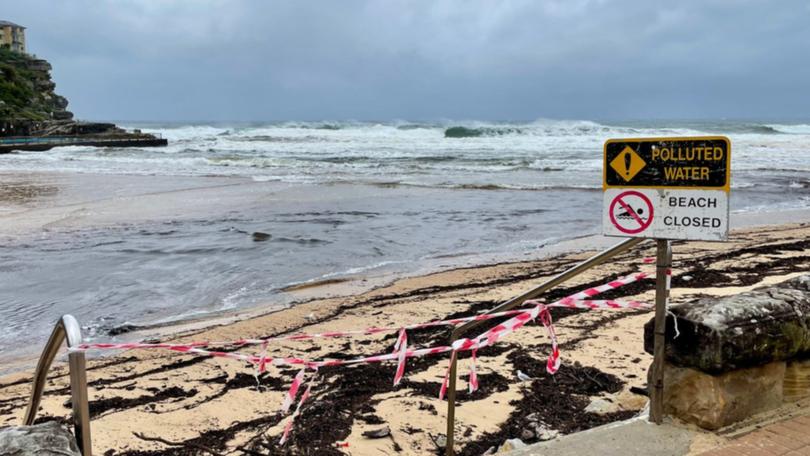‘Not good enough’: Water quality expert slams sickening levels of ‘faecal matter’ at Sydney beaches

A water quality expert has slammed the state of Sydney’s swimming spots after dozens were found to regularly contain unsafe levels of faecal matter.
The disturbing findings have in part been blamed on the state’s sewage systems, which overflow when they reach capacity and “drain to waterways, usually via the stormwater system,” the NSW State of the Beaches 2023-24 report said.
Most of these sewage systems are owned by Sydney Water, and Western Sydney University chief scientist Dr Ian Wright, who worked for the company for 20 years, said the company needs to “do better”.
Sign up to The Nightly's newsletters.
Get the first look at the digital newspaper, curated daily stories and breaking headlines delivered to your inbox.
By continuing you agree to our Terms and Privacy Policy.“When it rains, water does get into sewers ... it often overloads,” he told 7NEWS.com.au.
When these overflows occur, dangerous water-borne diseases can leech into the state’s iconic waterways, threatening the health of those who enjoy them.
Sydney’s sewage water only undergoes “primary treatment” before it is pumped into the ocean, 80m deep, between 2km to 3km offshore from Malabar, Manly and Bondi.
Primary treatment of sewage, which Wright said “would not be acceptable in Europe” is only the removal of larger particles and sedimentary sludge.
“It’s not good enough ... we are not keeping up ... we can do a lot better, and we should,” Wright said.
“Even in America, they have been pushing for higher treatment for 50 years — and Sydney is the only capital city (in Australia) that would release waste to the environment at the level of primary treatment.”
But the stormwater system, where overflowing sewage is discharged, undergoes no treatment before it hits the natural environment.
Sydney Water sewers have built-in overflow points in a number of areas, including Lane Cove River West, Scotts Creek, Tunks Park, and Quakers Hat Bay, which can store 500 million litres of overflowing water.
But in a city with a booming population, and more frequent heavy rainfall events in NSW due to climate change, that capacity if not drastically expanded will continue to be reached more frequently, Wright told 7NEWS.com.au.
“There’s so much development, think about Penrith or Chatswood or Hurstville — they’re like mini CBDs now, but they were built with water and sewer mains, underground, for much smaller populations,” he said.
“Sydney Water is always trying to catch up.”
Waterways where ‘it can’t easily dilute’
While the ocean’s salt water acts as a mild antiseptic, and its waves work to dissipate and dilute the wastewater discharged into it, “there are often effects out there in the ocean that we don’t fully comprehend,” Wright said.
“Because of the very high nutrient levels, and all kind of other things like all the pharmaceuticals that people use, from the contraceptive pill to antibiotics and mental health medication — sewage treatment doesn’t remove that.”
And sewer overflows which make their way into more stagnant bodies of water leave an unsafe levels of pollution for much longer.
“I spent hours looking over (NSW State of the Beaches 2023-24 report) data, and everything in enclosed waterways — Pittwater, Narrabeen Lagoon, even Botany Bay, any of those bay areas that aren’t directly connected to the ocean — they had worse water quality after wet weather,” Wright said.
“It can’t easily dilute, same for the upper-Parramatta River. For a week after rain, especially up in the CBD area, it’s really stinky because it doesn’t get that flushing out.”
The BeachSafe water quality report shows that Foreshores Beach and Gymea Bay Baths “continued to be graded as Very Poor” in 2024 and were “significantly impacted by faecal contamination during and following rainfall, and occasionally during dry weather.”
It contributed the foul findings to “sewage overflows that periodically discharge into Mill Stream”.
Wright added that for unsafe levels of faecal matter in waterways during dry weather, the contamination is usually always a result of a burst sewage main, or a blockage causing an overflow.
Wright suspects the mysterious balls that have been washing up on Sydney’s beaches are also linked to the state’s sewers, as the balls were previously found to contain matter that commonly passes through them — traces of faecal matter, fats, and drugs, according to The Conversation.
‘If the water looks off, and smells off — it’s off’
BeachSafe offers daily water quality updates online, with daily rainfall forecasts compared against data collected at NSW swimming spots where water is tested for Enterococci, an organism found in faecal matter.
It is unclear whether physical signage is erected at every affected body of water each time there is contamination.
And swimmers without internet access, internet literacy, or knowledge of the online BeachSafe alerts, may not be aware of potential dangers lurking at their local beach.
Elderly and migrant populations can fall into this category, with the former being some of the state’s most vulnerable to the spread of disease.
“Many of these water-borne illnesses, if you’ve got a weak immune system, or for young people, old people, sick people — this could be the thing that pushes them over the edge,” Wright said.
“Think of someone who has just had surgery or something. The water bears your weight so it’s a nice hydrotherapy exercise, but if the water quality is bad, that could be the worst thing in the world, if one of these diseases jumped.”
‘Don’t put your head under’
Wright said swimmers should still rely on their “human senses of sight and smell” to tell if the water is safe to swim in, and BeachSafe also echoes that advice on its website.
“Even if they sample every week or every six days, we still don’t know at that moment you jump in the water, what’s in there,” Wright said.
“Smell is really powerful. If the water looks off, and smells off — it’s off.”
Wright is a keen swimmer whose community relies on getting in the water daily for their wellbeing. In the scorching heat the state is known for, they are joined by even tentative swimmers looking to cool down with a dip.
His advice for those desperate to enter potentially contaminated water: “Don’t put your head under.”
“Eyes, ears, nose throat, that’s quite a vulnerable place to pick up a waterborne illness,” Wright said.
Regulation and plans for upgrade
“There’s more than 10,000km of sewer mains crisscrossing Sydney,” Wright said.
Those mains are highly regulated by the NSW Environmental Protection Agency (EPA), which specifically monitors Sydney Water’s sewage overflow performance.
Wright said “the EPA regularly fines” Sydney Water, but because it is a “government-owned company that makes millions” the fines are comparatively, relatively small, Wright said.
A NSW Environment Protection Authority (EPA) spokesperson told 7NEWS.com.au in the last two years it has “secured seven convictions and Enforceable Undertakings from Sydney Water relating to wastewater overflows.”
“These have resulted in more than $1.6 million in fines and contributions to environmental projects,” they said.
“In the last few years, we have also issued Sydney Water with several penalty notices and significant licence variations, including adding Pollution Reduction Programs, to make sure that Sydney Water’s system is meeting its obligations.”
Despite over 40 swimming spots that regularly had “poor” water quality results in 2024, a Sydney Water spokesperson told 7NEWS.com.au the “overall water quality at Sydney beaches remained at a high standard”.
“Due to unprecedented and prolonged wet weather events, which can increase the amount of debris and pollutants entering our waterways, the biggest contributing factor impacting water quality comes from stormwater runoff entering our waterways and increasing wet weather overflows from Sydney Water assets.”
Sydney Water plans to invest $57 million into stormwater projects to improve waterway health through the Wet Weather Overflow Abatement (WWOA) program over the next five years, the spokesperson said.
“Sydney Water has also developed a long-term capital operating plan, which will see over $30 billion invested in the next 10 years to upgrade and expand our water and wastewater networks,” the spokesperson said.
Originally published on 7NEWS
